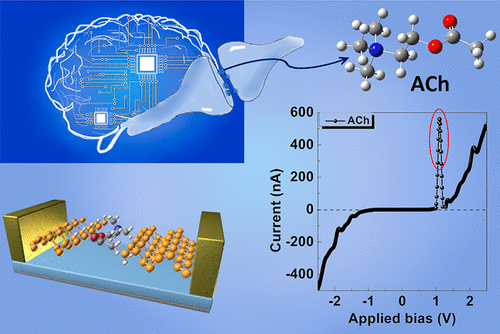当前位置:
X-MOL 学术
›
ACS Appl. Bio Mater.
›
论文详情
Our official English website, www.x-mol.net, welcomes your
feedback! (Note: you will need to create a separate account there.)
Single-Molecule Detection of Acetylcholine by Translating the Neuronal Signal to a Single Distinct Electronic Peak
ACS Applied Bio Materials ( IF 4.6 ) Pub Date : 2020-09-09 , DOI: 10.1021/acsabm.0c00797 Xinyue Dai 1 , Kai Le 1 , Fenglong Wang 1 , Rubin Wei 1 , Jiurong Liu 1 , Yanyan Jiang 1 , Hui Li 1
ACS Applied Bio Materials ( IF 4.6 ) Pub Date : 2020-09-09 , DOI: 10.1021/acsabm.0c00797 Xinyue Dai 1 , Kai Le 1 , Fenglong Wang 1 , Rubin Wei 1 , Jiurong Liu 1 , Yanyan Jiang 1 , Hui Li 1
Affiliation

|
The bioelectric signal deriving from acetylcholine (ACh) plays an important role in regulating body function. Translating neuronal signals to electrical current peaks is a promising approach to achieve rapid detection of the bioelectric signal, but direct nanodevice-based single-molecule detection of the neurotransmitter is hampered by technology. Herein, we propose a neurotransmitter molecular nanogap device composed of atomically thin black phosphorus (BP) electrodes, which could rapidly distinguish the single distinct electronic peak of ACh at low positive bias from other central neurotransmitters. It is the first time that this unique electronic signal has been found, which originates from its quaternary ammonium group, and it has been experimentally verified in the linear sweep voltammetry (LSV) curves measured at 0.3 mV s–1 in 0.01 M acetycholine chloride aqueous solution. Furthermore, our results suggest that replacing the N atom with a P atom can not only reverse the current signal but also change the signal magnitude in ACh or choline nanoelectronic devices. Importantly, all these appealing properties can even be assembled as components to make these molecules into parallel heterojunctions, making them a promising candidate for applications in forward or backward rectifying diodes. These results provide a theoretical basis for the creative applications of a BP electrode-based nanogap device in the rapid and single-molecule level detection of ACh, an electrochemical understanding for the mechanism of the signal transmission between neurons, and a physical approach to controlling the complex biological signal transduction in organisms. Ultimately, our findings lay the basis for next-generation biomedical solutions to clinical problems in the neurologic field.
中文翻译:

通过将神经元信号转化为单个不同的电子峰来单分子检测乙酰胆碱
来自乙酰胆碱(ACh)的生物电信号在调节机体功能方面发挥着重要作用。将神经元信号转换为电流峰值是实现快速检测生物电信号的一种有前途的方法,但基于纳米器件的直接神经递质单分子检测受到技术的阻碍。在此,我们提出了一种由原子级薄黑磷(BP)电极组成的神经递质分子纳米间隙装置,该装置可以快速区分低正偏压下 ACh 的单个不同电子峰与其他中枢神经递质。这是第一次发现这种独特的电子信号,它来源于其季铵基团,并在 0.3 mV s 测量的线性扫描伏安 (LSV) 曲线中得到了实验验证–1在 0.01 M 乙酰胆碱氯化物水溶液中。此外,我们的结果表明,用 P 原子代替 N 原子不仅可以反转电流信号,还可以改变 ACh 或胆碱纳米电子器件中的信号幅度。重要的是,所有这些吸引人的特性甚至可以组装成组件,使这些分子形成平行异质结,使其成为正向或反向整流二极管应用的有希望的候选者。这些结果为基于 BP 电极的纳米间隙器件在 ACh 快速和单分子水平检测中的创造性应用、对神经元之间信号传递机制的电化学理解以及控制 ACh 的物理方法提供了理论基础。生物体中复杂的生物信号转导。最终,
更新日期:2020-10-21
中文翻译:

通过将神经元信号转化为单个不同的电子峰来单分子检测乙酰胆碱
来自乙酰胆碱(ACh)的生物电信号在调节机体功能方面发挥着重要作用。将神经元信号转换为电流峰值是实现快速检测生物电信号的一种有前途的方法,但基于纳米器件的直接神经递质单分子检测受到技术的阻碍。在此,我们提出了一种由原子级薄黑磷(BP)电极组成的神经递质分子纳米间隙装置,该装置可以快速区分低正偏压下 ACh 的单个不同电子峰与其他中枢神经递质。这是第一次发现这种独特的电子信号,它来源于其季铵基团,并在 0.3 mV s 测量的线性扫描伏安 (LSV) 曲线中得到了实验验证–1在 0.01 M 乙酰胆碱氯化物水溶液中。此外,我们的结果表明,用 P 原子代替 N 原子不仅可以反转电流信号,还可以改变 ACh 或胆碱纳米电子器件中的信号幅度。重要的是,所有这些吸引人的特性甚至可以组装成组件,使这些分子形成平行异质结,使其成为正向或反向整流二极管应用的有希望的候选者。这些结果为基于 BP 电极的纳米间隙器件在 ACh 快速和单分子水平检测中的创造性应用、对神经元之间信号传递机制的电化学理解以及控制 ACh 的物理方法提供了理论基础。生物体中复杂的生物信号转导。最终,











































 京公网安备 11010802027423号
京公网安备 11010802027423号